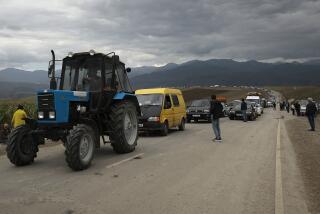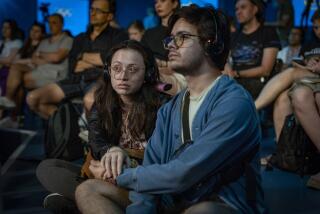Grieving Armenian Woman Overcomes All Odds to Visit Devastated Homeland
- Share via
A few hours after the Dec. 7 earthquake in Armenia, which killed an estimated 50,000 people, Kima Panosian announced that she would return to her homeland--immediately.
“She just sat on the couch that night and said, ‘I’m going to go,’ ” said Panosian’s 19-year-old daughter, Marine.
Never mind that Panosian, an engineer from El Monte who heads a small construction company in Pico Rivera, had no visa. Forget the 6,000 miles that separated her from her native Leninakan or the devastation that she was likely to encounter if she could, by a series of lucky breaks, reach her destination. She was going.
And she did, reaching her hometown within three days of the earthquake. She pulled into Leninakan before dawn on Dec. 10, an implacable figure carrying six suitcases full of clothes and antibiotics, among the first outsiders to reach the city--which was about 80% destroyed--as trapped victims still cried out for help from beneath the rubble.
“She’s a very strong woman,” said her daughter.
Kima Panosian, 46, a statuesque blonde woman with pained gray eyes, last week haltingly told the story of her one-week odyssey, which included a sleepless intercontinental flight to Moscow, a connecting flight to Armenia, an 80-mile drive through the heart of the destruction and an early-morning vision of her hometown, rendered unrecognizable by the earthquake.
“All my life, I will have these pictures in my mind,” said Panosian, dressed in mourner’s black in the office of Kima Construction.
Countless people she encountered along the way told her that traveling to Leninakan would be “impossible.” But Panosian flew to San Francisco and, by sheer force of personality, persuaded the Soviet consulate to give her a visa.
“I tell the Russian man, ‘I need to go to Armenia,” said Panosian in broken English. “He looks and looks and looks. Then he gives me the visa.” She pounds the table as if she were stamping a document.
From there, she rushed back to Los Angeles International Airport, where relatives waited with her suitcases, and hopped onto the first available flight to Moscow.
“I go there, even if I have to walk from Moscow to Yerevan,” she said. The distance between Moscow and the Armenian capital is about 1,100 miles.
By Friday, after another plane ride, she was in Yerevan, where she hired a car and driver. “He said, ‘I know we not get through,’ ” Panosian recalled. “But I say, ‘Let’s try.’ ”
Arrived in Leninakan
Bulldozing her way through Army checkpoints (“I explain to everybody, ‘My family is dead’ ”), Panosian arrived in Leninakan about 4 a.m. Saturday.
Even now, three weeks after she returned from Armenia, Panosian flounders to explain what compelled her. Perhaps it was a deep reflex that sent her rocketing through the night. “To be honest with you,” Panosian said, “it was for me more. You need to do something. You give $100,000--that different. You need to go touch them, be with them.”
Her relatives in Leninakan who lived through the quake understood perfectly. “I find them all together in a small room in my mother’s house,” Panosian recalled. “Nobody sleeping. No light, just a small candle. You know what my brother said? ‘I told you my sister come.’ ”
She considers her family among the more fortunate. Of 62 relatives in Leninakan, 22 were killed, including Panosian’s beloved 28-year-old niece, Sylvart.
Panosian leafs through a photograph album and points to a picture of a dark, serious-looking young woman. “She’s a person who was very, very close,” said Marine, a graphic artist. “Sylvart is gone.”
Panosian’s 5 days in Leninakan, a small city near the Turkish border, were full of nightmarish details.
As a latecomer, Panosian found that she was one of the few who could grasp the enormity of the catastrophe. “Some people just walk the streets and think about who died that day,” she said. “Everybody is asking, ‘How many people you lost?’ Everyone lost thousands. Close friends, people they went to school with.”
Her brother spent 14 days digging through the rubble of a refrigeration plant where Sylvart, also an engineer, had been working.
“From 25 minutes after the earthquake to 14 days later, my brother worked to get her out,” said Panosian, who helped the rescue effort by transporting the children of the family to homes in Yerevan, 80 miles away. “They know she is dead.”
But uncertainty was worse than death, Panosian said. “The worst thing is not people who lost their families but the ones who don’t know where their families are,” she said.
More to Read
Sign up for Essential California
The most important California stories and recommendations in your inbox every morning.
You may occasionally receive promotional content from the Los Angeles Times.










